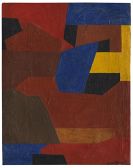
Gerhard Richter
Dresden
1932
The German painter Gerhard Richter is born in Dresden on February 9, 1932. He spends his childhood and youth in Waltersdorf in the Oberlausitz. He studies painting at the Dresden Art Academy from 1951 to 1956. In 1961, just a few months before the wall is built, Richter leaves the GDR and goes to Düsseldorf where he studies at the Art Academy from 1961 to 1963.
Gerhard Richter gets important stimuli for his own art when attending the "documenta" II in Kassel as early as in 1959, where mostly abstract post-war art is on exhibition. His own early work shows influences of informal art, the Fluxus movement as well as Pop-Art.
Gerhard Richter is friends with Sigmar Polke and Blinky Palermo during his study years in Düseldorf. Richter, Polke and Konrad Fischer-Lueg organize an art happening called "Leben mit Pop - Eine Demonstration für den Kapitalistischen Realismus" (Life with Pop - A Demonstration for Capitalist Realism)in a Düsseldorf furniture store in 1963. In the frame of this event, Richter presents his "graue Fotobilder" (Grey Photographs) for the first time.
A characteristic feature of Richter's work is the fact that he, up until today, has always taken a deep look into art itself. His works cannot be regarded in categories of "-isms", it is difficult to ascribe them to a certain style, it is rather seen in terms of a stylistic incongruity, thus his oeuvre is extremely complex and diversified.
Gerhard Richter paints his pictures after photographs of any kind, which he then reproduces in manifold ways. They are recognizable, due to the realistic style, but they are also concealed or simply drawn over, so that the motif, its content, is obscured, such s in the series "Vermalungen" (Misdrawings).
The group of works called "Farbtafeln" (Color Plates) is made as of 1966, for which Gerhard Richter sets various colors side by side, after the model of the Natural Color System. Gerhard Richter works on the "Grauen Bildern" (Grey Pictures) from 1967 to 1975. He recurrently turns to single motifs, for instance the "Seestücke" (Sea Pieces), the "Kerzen"-Bilder (Candle Pictures), the "Wolken"-Bilder (Cloud Pictures) or the "Schweizer Alpen" (Swiss Alps). He begins numbering his works consecutively as early as of 1962.
He is chosen as the first single artist to do the German pavilion for the Biennale in Venice in 1972. He does a series of 48 portraits, standardized images after photos of important intellectuals, such as natural scientists, philosophers, poets etc. Richter's works are shown at all "documenta"- exhibitions V to X. Numerous further exhibitions both on an national as well as an international level as well as art awards are proof of Richter being one of the most influential and successful contemporary artists.
Gerhard Richter lives and works in Cologne.
Would you like to sell a work by Gerhard Richter?
Infos for seller












